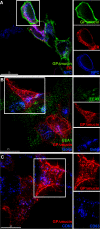Full-length Ebola glycoprotein accumulates in the endoplasmic reticulum
- PMID: 21223600
- PMCID: PMC3024955
- DOI: 10.1186/1743-422X-8-11
Full-length Ebola glycoprotein accumulates in the endoplasmic reticulum
Abstract
The Filoviridae family comprises of Ebola and Marburg viruses, which are known to cause lethal hemorrhagic fever. However, there is no effective anti-viral therapy or licensed vaccines currently available for these human pathogens. The envelope glycoprotein (GP) of Ebola virus, which mediates entry into target cells, is cytotoxic and this effect maps to a highly glycosylated mucin-like region in the surface subunit of GP (GP1). However, the mechanism underlying this cytotoxic property of GP is unknown. To gain insight into the basis of this GP-induced cytotoxicity, HEK293T cells were transiently transfected with full-length and mucin-deleted (Δmucin) Ebola GP plasmids and GP localization was examined relative to the nucleus, endoplasmic reticulum (ER), Golgi, early and late endosomes using deconvolution fluorescent microscopy. Full-length Ebola GP was observed to accumulate in the ER. In contrast, GPΔmucin was uniformly expressed throughout the cell and did not localize in the ER. The Ebola major matrix protein VP40 was also co-expressed with GP to investigate its influence on GP localization. GP and VP40 co-expression did not alter GP localization to the ER. Also, when VP40 was co-expressed with the nucleoprotein (NP), it localized to the plasma membrane while NP accumulated in distinct cytoplasmic structures lined with vimentin. These latter structures are consistent with aggresomes and may serve as assembly sites for filoviral nucleocapsids. Collectively, these data suggest that full-length GP, but not GPΔmucin, accumulates in the ER in close proximity to the nuclear membrane, which may underscore its cytotoxic property.
Figures



References
-
- Chan SY, Ma MC, Goldsmith MA. Differential induction of cellular detachment by envelope glycoproteins of Marburg and Ebola (Zaire) viruses. J Gen Virol. 2000;81:2155–2159. - PubMed
Publication types
MeSH terms
Substances
Grants and funding
LinkOut - more resources
Full Text Sources
Medical
Molecular Biology Databases
Miscellaneous

